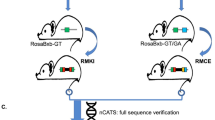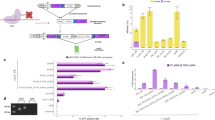Abstract
Efficient transfer of chromosome-based vectors into mammalian cells is difficult, mostly due to their large size. Using a genetically engineered invasive Escherichia coli vector, alpha satellite DNA cloned in P1-based artificial chromosome was stably delivered into the HT1080 cell line and efficiently generated human artificial chromosomes de novo. Similarly, a large genomic cystic fibrosis transmembrane conductance regulator (CFTR) construct of 160 kb containing a portion of the CFTR gene was stably propagated in the bacterial vector and transferred into HT1080 cells where it was transcribed, and correctly spliced, indicating transfer of an intact and functional locus of at least 80 kb. These results demonstrate that bacteria allow the cloning, propagation and transfer of large intact and functional genomic DNA fragments and their subsequent direct delivery into cells for functional analysis. Such an approach opens new perspectives for gene therapy.
This is a preview of subscription content, access via your institution
Access options
Subscribe to this journal
Receive 12 print issues and online access
$259.00 per year
only $21.58 per issue
Buy this article
- Purchase on Springer Link
- Instant access to full article PDF
Prices may be subject to local taxes which are calculated during checkout







Similar content being viewed by others
Accession codes
References
Shizuya H et al. Cloning and stable maintenance of 300-kilobase-pair fragments of human DNA in Escherichia coli using an F-factor-based vector. Biochemistry 1992; 89: 8794–8797.
Ioannou PA et al. A new bacteriophage P1-derived vector for the propagation of large human DNA fragments. Nat Genet 1994; 6: 84–89.
International Human Genome Mapping Consortium. A physical map of the human genome. Nature 2001; 409: 934–941.
Schindelhauer D, Schwarz T . Evidence for a fast, intrachromosomal conversion mechanism from mapping of nucleotide variants within a homogeneous alpha-satellite DNA array. Genome Res 2002; 12: 1815–1826.
Ebersole TA et al. Mammalian artificial chromosome formation from circular alphoid input DNA does not require telomere repeats. Hum Mol Genet 2000; 9: 1623–1631.
Harrington JJ et al. Formation of de novo centromeres and construction of first-generation human artificial microchromosomes. Nat Genet 1997; 15: 345–355.
Ikeno M et al. Construction of YAC-based mammalian artificial chromosomes. Nat Biotechnol 1998; 16: 431–439.
Grimes BR, Rhoades AA, Willard HF . Alpha-satellite DNA and vector composition influence rates of human artificial chromosome formation. Mol Ther 2002; 5: 798–805.
Henning KA et al. Human artificial chromosomes generated by modification of a yeast artificial chromosome containing both human alpha satellite and single-copy DNA sequences. Proc Natl Acad Sci USA 1999; 96: 592–597.
Schueler MG et al. Genomic and genetic definition of a functional human centromere. Science 2001; 294: 109–115.
Kouprina N et al. Cloning of human centromeres by transformation associated recombination in yeast and generation of functional human artificial chromosomes. Nucleic Acids Res 2003; 31: 922–934.
Meija JE et al. Efficiency of de novo centromere formation in human artificial chromosomes. Genomics 2002; 79: 297–304.
Ohzeki J, Nakano M, Masumoto H . CENP-B box is required for de novo centromere chromatin assembly on human alphoid DNA. J Cell Biol 2002; 159: 765–775.
Meija JE et al. Functional complementation of a genetic deficiency with human artificial chromosomes. Am J Hum Genet 2001; 69: 315–326.
Grimes BR et al. Stable gene expression from a human artificial chromosome. EMBO Rep 2001; 21: 910–914.
Ikeno M et al. Generation of human artificial chromosomes expressing naturally controlled guanosine triphosphate cyclohydrolase I gene. Genes Cell 2002; 7: 1021–1032.
Wade-Martins R et al. An infectious transfer and expression system for genomic DNA loci in human and mouse cells. Nat Biotechnol 2001; 19: 1067–1070.
Magin-Lachmann C et al. In vitro and in vivo delivery of intact BAC DNA – comparison of different methods. J Gen Med 2004; 6: 195–209.
Courvalin P, Goussard S, Grillot-Courvalin C . Gene transfer from bacteria to mammalian cells. CR Acad Sci 1995; 318: 1207–1212.
Grillot-Courvalin C et al. Functional gene transfer from intracellular bacteria to mammalian cells. Nat Biotechnol 1998; 16: 862–866.
Narayanan K, Warburton PE . DNA modification and functional delivery into human cells using Escherichia coli DH10B. Nucleic Acids Res 2003; 31: e51.
Laner A, Schwarz T, Christan S, Schindelhauer D . Suitability of a CMV / EGFP cassette to monitor stable expression from human artificial chromosomes but not transient transfer in the cells forming viable clones. Cytogenet Genome Res 2004; 107: 9–13.
Schindelhauer D et al. An engineered genomic CFTR construct is expressed and correctly spliced in the human lung sarcoma cell line HT1080. (submitted).
Bachmann BJ . Derivations and genotypes of some mutant derivatives of Escherichia coli K-12. In: Brooks LK, Ingraham JL, Magasanik B, Neidhardt FC, Schaechter M, Umbarger HE (eds). Escherichia coli and Salmonella Typhimurium, Cellular and Molecular Biology. ASM: Washington, 1987, pp 1190–1219.
Grillot-Courvalin C, Goussard S, Courvalin P . Bacteria as gene delivery vectors for mammalian cells. Curr Opin Biotechnol 1999; 10: 477–481.
Weiss S, Chakraborty T . Transfer of eukaryotic expression plasmids to mammalian host cells by bacterial carriers. Curr Opin Biotechnol 2001; 12: 467–472.
Sizemore DR, Branstrom AA, Sadoff JC . Attenuated Shigella as a DNA delivery vehicle for DNA-mediated immunization. Science 1995; 270: 299–302.
Fajac I et al. Recombinant Escherichia coli as a gene delivery vector into airway epithelial cells. J Control Rel 2004; 97: 371–381.
Darji A et al. Oral somatic transgene vaccination using attenuated S. typhimurium. Cell 1997; 91: 765–775.
Dietrich G et al. Delivery of antigen-encoding plasmid DNA into the cytosol of macrophages by attenuated suicide Listeria monocytogenes. Nat Biotechnol 1998; 16: 181–185.
Paglia P et al. Gene transfer in dendritic cells, induced by oral DNA vaccination with Salmonella typhimurium, results in protective immunity against a murine fibrosarcoma. Blood 1998; 92: 3172–3176.
Paglia P et al. In vivo correction of genetic defects of monocyte / macrophages using attenuated Salmonella as oral vectors for targeted gene delivery. Gene Therapy 2000; 7: 1725–1730.
Castagliuolo I et al. Engineered Escherichia coli deliver therapeutic genes to the colonic mucosa of mice. Gene Therapy 12: 1070–1078.
Lipps HJ et al. Chromosome-based vectors for gene therapy. Gene 2003; 304: 23–33.
Klink D et al. Gene delivery systems-gene therapy vectors for cystic fibrosis. J Cystic Fibrosis 2004; 3: 203–212.
Narayanan K et al. Efficient and precise engineering of a 200 kb β-globin human / bacterial artificial chromosome in E. coli DH10B using an inducible homologous recombinant system. Gene Therapy 1999; 6: 442–447.
Grillot-Courvalin C, Goussard S, Courvalin P . Wild-type intracellular bacteria deliver DNA into mammalian cells. Cell Microbiol 2002; 4: 177–186.
Rudd MK, Mays RW, Schwartz S, Willard HF . Human artificial chromosomes with alpha satellite-based de novo centromeres show increased frequency of nondisjunction and anaphase lag. Mol Cell Biol 2003; 23: 7689–7697.
Zielenski J et al. Genomic DNA sequence of the cystic fibrosis transmembrane conductance regulator (CFTR) gene. Genomics 1991; 10: 214–228.
Brune W, Ménard C, Heesemann J, Koszinowski UH . A ribonucleotide reductase homolog of cytomegalovirus and endothelial cell tropism. Science 2001; 291: 303–305.
Archidiacano N et al. Comparative mapping of human alphoid sequences in great apes using fluorescence in situ hybridization. Genomics 1995; 25: 477–484.
Hulsebos TJ et al. Assignment of the beta B1 crystallin gene (CRYBB1) to human chromosome 22 and mouse chromosome 5. Genomics 1995; 29: 712–718.
Grant SGN, Jessee J, Bloom FR, Hanahan D . Differential plasmid rescue from transgenic mouse DNAs into Escherichia coli methylation-restriction mutants. Genetics 1990; 87: 4645–4649.
Schindelhauer D, Cooke HJ . Efficient combination of large DNA in vitro: in gel site specific recombination (IGSSR) of PAC fragments containing alpha satellite DNA and the human HPRT gene locus. Nucleic Acids Res 1997; 25: 2241–2243.
Warburton PE, Willard HF . Genomic analysis of sequence variation in tandemly repeated DNA. Evidence for localized homogeneous sequence domains within arrays of α-satellite DNA. J Mol Biol 1990; 216: 3–16.
Ramalho AS et al. Methods for RNA extraction, cDNA preparation and analysis of CFTR transcripts. J Cystic Fibrosis 2004; 3: 11–15.
Ramalho AS et al. Five percent of normal cystic fibrosis transmembrane conductance regulator mRNA ameliorates the severity of pulmonary disease in cystic fibrosis. Am J Respir Cell Mol Biol 2002; 27: 619–627.
Mickle JE et al. A mutation in the cystic fibrosis transmembrane conductance regulator gene associated with elevated sweat chloride concentrations in the absence of cystic fibrosis. Hum Mol Genet 1998; 7: 729–735.
Chalkley G, Harris AA . Lymphocyte mRNA as a resource for detection of mutations and polymorphisms in the CF gene. J Med Genet 1991; 28: 777–780.
Acknowledgements
This work was supported in part by two grants from l'association Vaincre la Mucoviscidose in 2002–2003 and 2003–2004, the latter together with the German Association Mukoviszidose e.v. D Schindelhauer was supported by the Deutsche Forschung Gemeinschaft and MD Amaral by research Grant POCTI / 1999 / MGI / 35737 from FCT Portugal. AS Ramalho was a recipient of PhD fellowship SFRH / BD / 3085 / 2000 from FCT, Portugal. We thank C Klein and M Speicher for FISH equipment.
Author information
Authors and Affiliations
Rights and permissions
About this article
Cite this article
Laner, A., Goussard, S., Ramalho, A. et al. Bacterial transfer of large functional genomic DNA into human cells. Gene Ther 12, 1559–1572 (2005). https://doi.org/10.1038/sj.gt.3302576
Received:
Accepted:
Published:
Issue Date:
DOI: https://doi.org/10.1038/sj.gt.3302576
Keywords
This article is cited by
-
Gene augmentation for autosomal dominant retinitis pigmentosa using rhodopsin genomic loci nanoparticles in the P23H+/− knock-in murine model
Gene Therapy (2023)
-
A pathway from chromosome transfer to engineering resulting in human and mouse artificial chromosomes for a variety of applications to bio-medical challenges
Chromosome Research (2015)
-
Characterization of a large human transgene following invasin-mediated delivery in a bacterial artificial chromosome
Chromosoma (2013)
-
CFTR expression and activity from the human CFTR locus in BAC vectors, with regulatory regions, isolated by a single-step procedure
Gene Therapy (2010)
-
Bactofection of lung epithelial cells in vitro and in vivo using a genetically modified Escherichia coli
Gene Therapy (2008)



